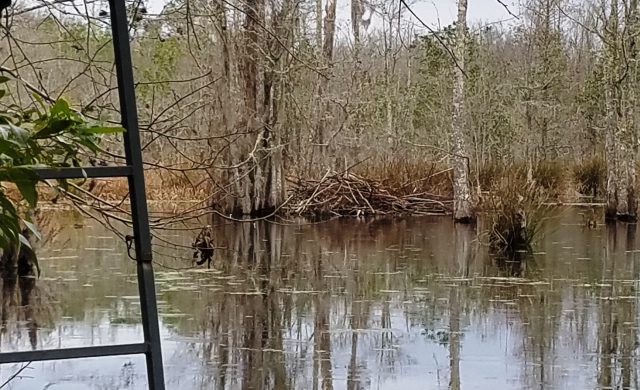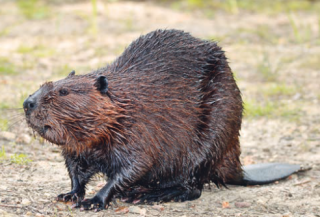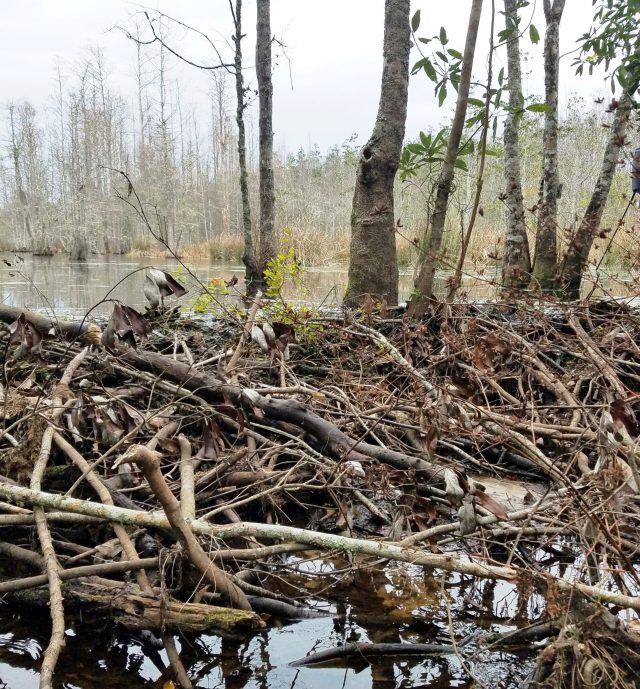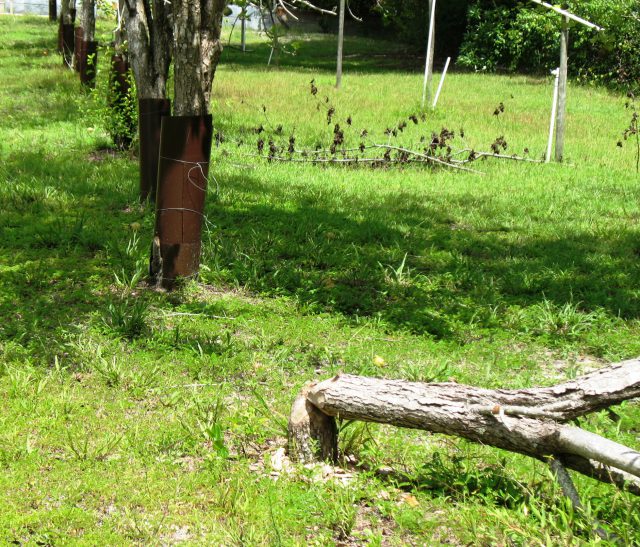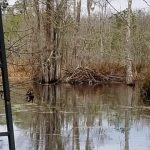
Even though the “work” beavers do can sometimes cause frustration to land owners, they are truly amazing creatures. A number of questions have come into the Extension Office lately about managing beavers, so it is a good time to discuss a little about the history and biology of these unique animals, as well as the management options available for land owners.
Beavers in the American Landscape
Hundreds of millions of beaver once occupied the North American continent until the 1900s, when the majority had been trapped out in the eastern United States for the fur trade (Baker, B.W., and E.P. Hill. 2003. Beaver (Castor canadensis)). “Growing public concern over declines in beaver and other wildlife populations eventually led to regulations that controlled harvest through seasons and methods of take, initiating a continent-wide recovery of beaver populations.” (Baker, B.W., and E.P. Hill. 2003. Beaver (Castor canadensis)). In its current range, the beaver “thrives throughout the Florida Panhandle and upper peninsula in streams, rivers, swamps or lakes that have an ample supply of trees.” (Florida Fish and Wildlife Conservation Commission, Aquatic Mammals, Beaver: Castor canadensis).
Adaptations
Source: FWC Living with Beavers
Beavers are the largest rodent in North America. In Florida, they commonly weigh between 30 – 50 pounds. Beavers are considered an aquatic mammal, having adaptations such as a streamlined shape, insulating fur, ears and nostrils that close while underwater, clear membranes that cover their eyes while underwater, large webbed feet, and a broad flat rudder-like tail that aid in swimming. They can remain underwater for 15 minutes at a time! Their tree-cutting, bark-peeling front teeth grow continuously, and as a result, are continuously sharpened as they grind against the lower teeth. (Baker, B.W., and E.P. Hill. 2003. Beaver (Castor canadensis), Florida Fish and Wildlife Conservation Commission, Aquatic Mammals, Beaver: Castor canadensis).
Habitat and Behaviors
Beavers typically mate for life and live in family groups consisting of the adult male and female, and one or two generations of young kits before they are old enough to disperse on their own. They are primarily nocturnal, being active from dusk to dawn. Beavers eat not only tree bark, leaves, stems, buds, and fruits, but herbaceous plants as well. Their diet is broad and can consist of aquatic plants, such as cattails and water lilies, shrubs, willow, grasses, acorns, tree sap, and sometimes even cultivated row crops. (Baker, B.W., and E.P. Hill. 2003. Beaver (Castor canadensis)).
Dam and Lodge Construction
The sound of moving water triggers beavers to build, repair, or maintain their dams. (Baker, B.W., and E.P. Hill. 2003. Beaver (Castor canadensis)). The two main structures they build are the water-slowing dam and their living quarters or lodge. The lodge is separate from the dam and is oftentimes located in the stream or pond bank. “The ponds created by dams also provide beavers with deep water where they can find protection from predators — entrances to dens or lodges are usually underwater. Some beavers in Florida do not build the massive stick lodges associated with northern colonies. Instead, they are more likely to live in deep dens in stream banks…” Florida Fish and Wildlife Conservation Commission, Aquatic Mammals, Beaver: Castor canadensis).
Impacts
Beavers are called “nature’s engineers” for good reason. Their tree cutting and building behaviors certainly alter surrounding landscapes. Outside of any connection to human civilization, their activities tend to increase diversity and habitat options for both plants and animals. Many scientists have examined the intricate biological and ecological effects beavers have on surrounding landscapes. Their activities in our backyard, however, do not always result in positive outcomes. Often, beavers are triggered to build dams in running water through road culverts causing significant impacts to road drainage, and surrounding flood management. Their construction of dams along creeks can flood farm fields and woodlands. Their feeding and tree cutting can kill desired trees in nearby timberland and orchards.
Management Options for Land Owners
The Florida Fish and Wildlife Conservation Commission (FWC) publication, “Living with Beavers” provides excellent advice, along with a summary of the regulations regarding this native wildlife species. As per this document, “The beaver is a native species with a year-round hunting and trapping season in Florida.” Beaver hunting and trapping regulations can be found on the FWC Furbearer Hunting and Trapping website. A beaver can be taken as a nuisance animal, if it causes or is about to cause property damage, presents a threat to public safety, or causes an annoyance in, under, or upon a building, per Florida Rule 68A-9.010.” Other recommendations from this FWC publication are:
- “Beaver dam removal provides immediate relief from flooding and can be the simplest and cheapest way of dealing with a beaver problem. However, beavers often quickly rebuild a dam as soon as it is damaged. “
- “When removing a dam is infeasible or unsuccessful, installing a water level control structure through the dam can allow for the control of water flow without removing the dam. This technique also reduces the likelihood of the beaver continuously blocking water flow. For technical assistance, contact a wildlife assistance biologist at a regional FWC office near you.”
- “If a beaver dam is blocking a culvert or similar structure, installing a barrier several feet away from the culvert can be the most effective solution. This prevents the beavers from accessing the culvert to dam it. Please contact a wildlife assistance biologist at a regional FWC office near you for technical assistance.”
- “Protect valuable trees and vegetation from beaver damage by installing a fence around them or wrapping tree trunks loosely with 3-5 feet of hardware cloth or multiple wraps of chicken wire. This prevents the beavers from chewing on the trees and other plants.”
- “Lethal control should be considered a last resort.”
FWC also points the reader to this publication from Clemson University Cooperative Extension Service, Department of Aquaculture, Fisheries and Wildlife, “The Clemson Beaver Pond Leveler.” This publication provides diagrams and a list of materials needed to construct a device which is designed to “minimize the probability that current flow can be detected by beavers, therefore minimizing dam construction.”
Links to the references used for this article:
-
Beaver (Castor canadensis). In: Wild Mammals of North America: biology, management, and conservation. Baker, B.W., and E.P. Hill. 2003. Second Edition. Baltimore, MD: The Johns Hopkins University Press. 288-310.
-
Aquatic Mammals, Beaver: Castor canadensis – Florida Fish and Wildlife Conservation Commission
-
Living with Beavers – Florida Fish and Wildlife Conservation Commission
-
The Clemson Beaver Pond Leveler – Clemson University Cooperative Extension Service, Department of Aquaculture, Fisheries and Wildlife
![]()
Posted: March 20, 2017
Category: Natural Resources, Wildlife
Tags: Beavers, Engineering, Farmer’s, Frustration, Marvel, Panhandle Outdoors
